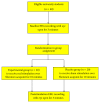Microcurrent stimulation at shenmen acupoint facilitates EEG associated with sleepiness and positive mood: a randomized controlled electrophysiological study
- PMID: 25767551
- PMCID: PMC4342064
- DOI: 10.1155/2015/182837
Microcurrent stimulation at shenmen acupoint facilitates EEG associated with sleepiness and positive mood: a randomized controlled electrophysiological study
Abstract
To examine the electrophysiological effects of microcurrent stimulation at the Shenmen acupoint, 40 healthy normal subjects were randomly assigned to a placebo group (sham stimulation) and an experimental group (bilateral electrocutaneous stimulation at the Shenmen). The following two electroencephalographic indicators were used to measure brain activity. (1) Arousal level was measured with reference to log-transformed absolute alpha power and power source and analyzed using low-resolution electromagnetic tomography and (2) frontal alpha asymmetry was used as an indicator of mood. After real stimulation for 10 minutes, absolute alpha power was globally reduced in the experimental group, particularly in the anterior and centrotemporal regions of the brain. This indicates a decline in the brain activity associated with arousal. Moreover, the reduction was more prominent in the left frontal region, as compared to the right frontal region, resulting in significant increase from negative to positive frontal alpha asymmetry scores and reflecting an increase in the brain activity associated with enhanced mood. However, the placebo group exhibited no significant changes in two indicators after sham stimulation. This study provides initial electrophysiological evidence of changes in brain activity associated with reduced arousal (and thus greater sleepiness) and enhanced mood after microcurrent stimulation at the Shenmen acupoint.
Figures



Similar articles
-
EEG topography and tomography (LORETA) in diagnosis and pharmacotherapy of depression.Clin EEG Neurosci. 2010 Oct;41(4):203-10. doi: 10.1177/155005941004100407. Clin EEG Neurosci. 2010. PMID: 21077572 Clinical Trial.
-
Low-Frequency Magnetic Stimulation of Shenmen Acupoint Reduces Blood Oxygen Levels in the Prefrontal Cortex of Healthy Subjects: A Near-Infrared Brain Functional Imaging Study.Chin J Integr Med. 2021 Aug;27(8):585-588. doi: 10.1007/s11655-021-3291-z. Epub 2021 Apr 21. Chin J Integr Med. 2021. PMID: 33881719
-
EEG EPs analysis of magnetic stimulation on acupoint of Shenmen(HT7).Annu Int Conf IEEE Eng Med Biol Soc. 2012;2012:5745-8. doi: 10.1109/EMBC.2012.6347299. Annu Int Conf IEEE Eng Med Biol Soc. 2012. PMID: 23367234
-
Asymmetrical frontal cortical activity associated with differential risk for mood and anxiety disorder symptoms: An RDoC perspective.Int J Psychophysiol. 2015 Nov;98(2 Pt 2):249-261. doi: 10.1016/j.ijpsycho.2015.06.004. Epub 2015 Jun 20. Int J Psychophysiol. 2015. PMID: 26100073 Review.
-
Frontal EEG Asymmetry of Mood: A Mini-Review.Front Behav Neurosci. 2017 Nov 6;11:224. doi: 10.3389/fnbeh.2017.00224. eCollection 2017. Front Behav Neurosci. 2017. PMID: 29209180 Free PMC article. Review.
Cited by
-
Self-Rated Recovery and Mood Before and After Resistance Training and Muscle Microcurrent Application.Front Psychol. 2022 Apr 14;13:836695. doi: 10.3389/fpsyg.2022.836695. eCollection 2022. Front Psychol. 2022. PMID: 35496154 Free PMC article.
-
Auricular acupressure as a complementary therapy for psoriasis vulgaris: study protocol for a multicenter randomized controlled trial.Trials. 2019 Jun 17;20(1):358. doi: 10.1186/s13063-019-3475-4. Trials. 2019. PMID: 31208470 Free PMC article.
-
Development of Home Beauty Devices for Facial Rejuvenation: Establishment of Efficacy Evaluation System.Clin Cosmet Investig Dermatol. 2024 Mar 8;17:553-563. doi: 10.2147/CCID.S449599. eCollection 2024. Clin Cosmet Investig Dermatol. 2024. PMID: 38476342 Free PMC article. Review.
-
Comparative evaluation of effect of microcurrent electrical stimulation on acupoints to control gag reflex in patients receiving prosthodontic treatment: An in vivo study.J Indian Prosthodont Soc. 2022 Apr-Jun;22(2):188-194. doi: 10.4103/jips.jips_228_21. J Indian Prosthodont Soc. 2022. PMID: 36511030 Free PMC article. Clinical Trial.
-
Evaluating the Effectiveness and Safety of Home Facial Antiaging Beauty Devices Based on Meridian and Acupoint Theory.J Cosmet Dermatol. 2025 Mar;24(3):e70096. doi: 10.1111/jocd.70096. J Cosmet Dermatol. 2025. PMID: 40099405 Free PMC article. Clinical Trial.
References
-
- Klawansky S., Yeung A., Berkey C., Shah N., Phan H., Chalmers T. C. Meta-analysis of randomized controlled trials of cranial electrostimulation. Efficacy in treating selected psychological and physiological conditions. Journal of Nervous and Mental Disease. 1995;183(7):478–484. doi: 10.1097/00005053-199507000-00010. - DOI - PubMed
-
- Pozos R. S., Strack L. E., White R. K., Richardson A. W. Electrosleep versus electroconvulsive therapy. In: Reynolds D. V., Sjorberg A. E., editors. Neuroelectric Research. Springfield, Ill, USA: Charles Thomas; 1971. pp. 221–225.
-
- Rosenthal S. H., Wulfsohn N. L. Studies of electrosleep with active and simulated treatment. Current Therapeutic Research. 1970;12(3):126–130. - PubMed
LinkOut - more resources
Full Text Sources
Other Literature Sources

